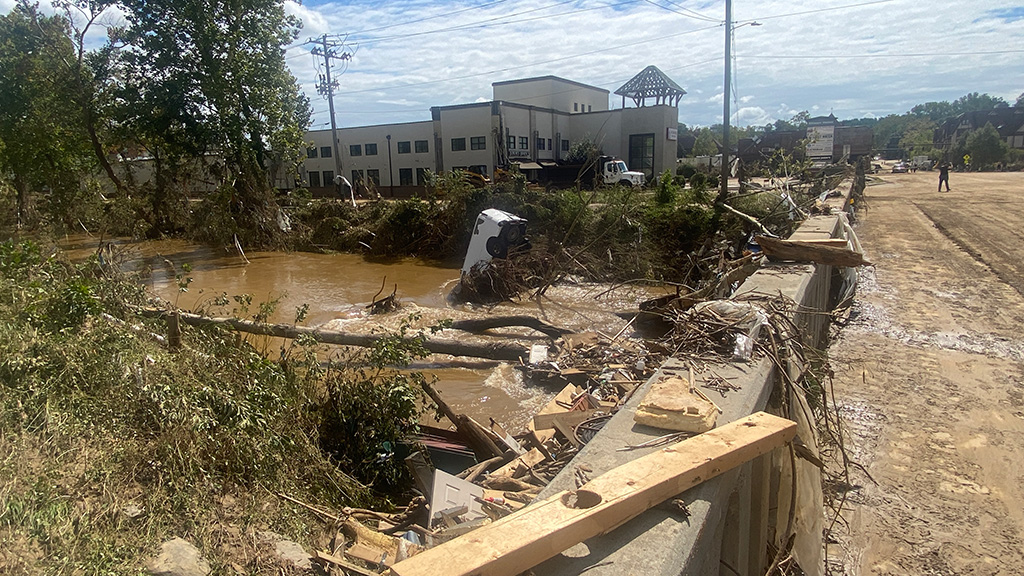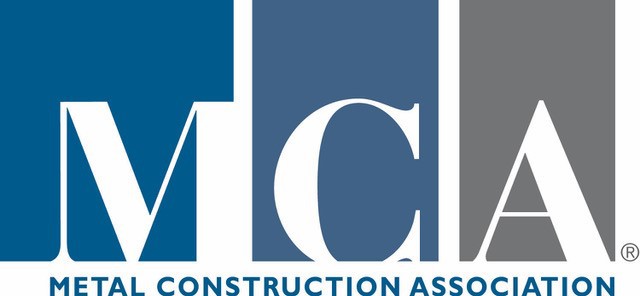This course is part of the Metal Architecture Academy
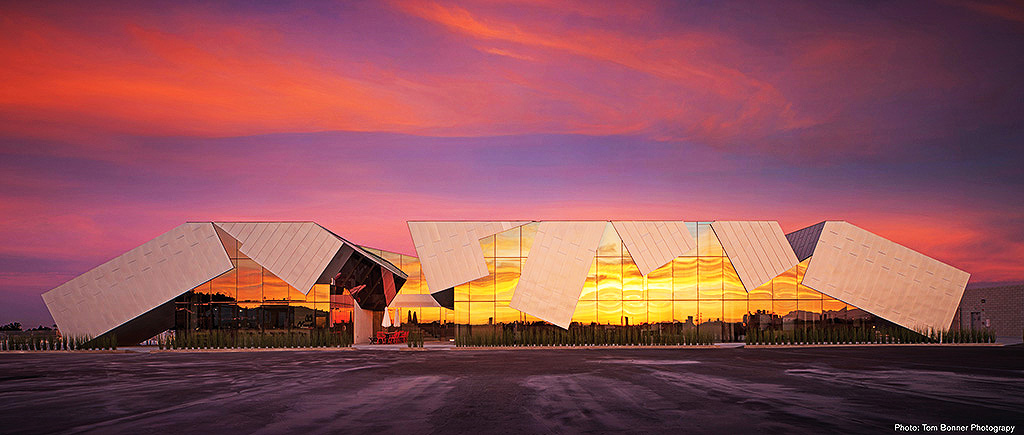
Photo by Tom Bonner Photography; photo courtesy of RHEINZINK
The versatile and beautiful appeal of metal roofs and walls provides aesthetic, creative options while also offering a durable and resilient shield for buildings.
As natural disasters grow more frequent and severe, building professionals are rethinking material choices to meet both natural and man-made challenges. This article examines how metal roofing, wall panels, and framing systems contribute to high-performance building envelopes that are both durable and resilient, meeting the growing concern about disasters in both commercial and residential market segments. This article will explore the performance advantages of metal in resisting high winds, hurricanes, wildfire ignition, hail impact, and water damage—especially in vulnerable coastal regions, common flood plain communities, and wildfire-prone regions located near or within wildland-urban interface areas. Also, we will review key standards such as NFPA 285, ASTM E1592, and Florida’s TAS 111(B) and 111(C) protocols, as we explore how code-aligned systems are tested for real-world conditions and even new science-backed programs including the most recent technical standard for Wildfire Prepared Neighborhood published by the Insurance Institute for Business & Home Safety (IBHS).
Resilience is the New Green
Buildings are under constant threat from both nature and man-made attacks. Humans are witnessing the impact of climate change on the planet, and while the debate about how to curb, halt, or even reverse climate change continues, the building community is recognizing the critical need to address threats today. Storms are becoming fiercer with high wind events challenging both coastal and inland communities. Rain, floods, and hail serve as constant threats to the building envelope. At the same time, the world is experiencing severe droughts that are longer and deeper, leaving drier conditions that grow into extended wildfire seasons and, ultimately, unprecedented disasters.
Responding to these challenges, the building community needs to address newly identified concerns about building in almost every climate zone. No region is free from the threat of severe weather events that can impact the health and safety of building owners and communities. Manufacturers of building products are constantly investigating new products and technologies to assist architects, community planners, builders, homeowners, and code bodies and officials to help limit destruction from weather-related events.
Central to this conversation is the shift from sustainable design with a recent focus on carbon reduction to a broader and more defensive design approach. The immediate task is to create buildings with the expectation that they will not only survive severe weather events but also remain open and accessible. The ability for a community to return to normal and thrive is dependent on how quickly services and infrastructure can rebound. The key is to make buildings resilient by design so they can withstand assaults of nature and man-made threats.
The first line of defense is the exterior building envelope. Considering the scale and scope of potential threats from wind, fire, and water, metal roofing and wall panels are the choice for resilient design. Metal’s natural properties create a strong, durable, and aesthetically pleasing outer shell. In recent years, metal has risen in popularity as a favored construction material. It is accessible with a multitude of compelling qualities and capacities that work in concert for a highly durable building.
In the interest of resilient structures, let’s explore the three threats to the built environment—wind, fire, and water—and also break down the code-specific requirements for metal roofing and walls.
Wind Load Resistance: A Key Factor in Extreme Weather Design
When strong winds interact with a building, they generate complex pressure zones across the roof and wall surfaces. For roofing applications, positive pressure pushes upward from inside, while negative suction develops as wind flows over and around roof edges and ridgelines. The greatest uplift forces often occur along the roof perimeter and corners—areas most prone to material detachment and progressive failure. When edge materials or coverings fail, they can peel back large roof sections, exposing the structure to water intrusion, more damage, and even catastrophic loss.
Wind load resistance is a fundamental performance requirement for building envelopes, particularly in hurricane-prone and high-wind regions. Metal roofing, cladding, and edge systems are often selected for their inherent strength and resilience, but meeting code-prescribed wind resistance levels requires rigorous testing and documentation. Building codes such as the International Building Code (IBC) and the Florida Building Code (FBC) specify that exterior systems must be tested to verify their ability to resist both positive (inward) and negative (uplift) pressure loads generated by wind events.
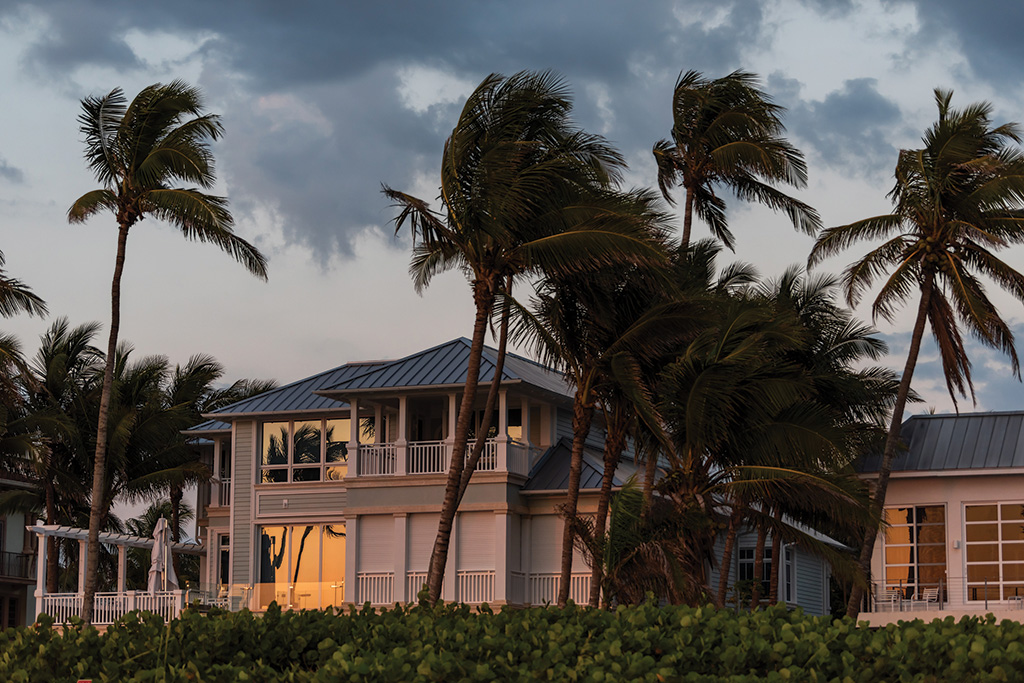
Photo courtesy of Getty Images
Wind load resistance is a fundamental performance requirement for building envelopes, particularly in High Velocity Hurricane Zone (HVHZ) regions.
For metal roofing systems, wind resistance is not only a matter of material strength but also system configuration, including panel profile, seam locking method, fastening patterns, and substrate compatibility. Design professionals must determine the appropriate design pressures based on building height, exposure category, roof geometry, and geographic location.
Guiding the engineer or architect on making these calculations is ASCE 7. ASCE 7 is provided by the American Society of Civil Engineers’ publication, Minimum Design Loads and Associated Criteria for Buildings and Other Structures. These design pressure calculations are a unique set of standardized methods used to determine the wind loads based on a variety of site-specific details like basic wind speed, orientation, height, and shape of the building, function or importance factor (for instance, hospitals require higher wind load capacity than warehouses), and direction of wind. Results of pressure, both positive and negative, are expressed in pounds per square foot (psf) and applied to the parts of the structure.
ASCE 7 is a valuable asset for reliably designing roof systems to withstand high wind events because wind pressures vary across the structure, with higher values concentrated at vulnerable areas like corners, ridgelines, and roof edges. The publication also provides formulas and procedures for calculating other loads such as snow, seismic, flood, and rain.
Once calculated, these positive and negative wind pressures are matched to tested assemblies using wind uplift protocols such as ASTM E 1592.
ASTM E 1592: Testing Metal Roofing Uplift Performance
ASTM E 1592 is the industry standard for evaluating the uplift resistance of metal roofing systems over open framing subjected to simulated wind pressures. ASTM E 1592 allows a more nuanced application of results compared to other test methods. It applies differential pressures across a roof mockup representing a specific area of the roof. This allows these assemblies to be combined with other assemblies to replicate the effects of real-world wind loads, including turbulence and suction effects near ridges and eaves. The protocol allows precise measurement of system behavior under varied but realistic conditions, including fastener pull-through, panel disengagement, and seam failure.
The test is particularly applicable to standing seam metal roofing (SSMR) systems, which depend on concealed fasteners and interlocking seams to resist uplift. During testing, the roof panel assembly—including panels, clips, underlayment, and substrate—is mounted in a pressure chamber where a vacuum system simulates increasing wind loads. Pressure levels are incrementally raised until failure occurs, or the system reaches its design threshold.
ASTM E 1592 results let designers and engineers determine the maximum allowable spacing for clips and fasteners, as well as the best type of substrate or purlin support. This test data is essential when designing buildings in areas subject to high winds, since underperforming systems can compromise both structural integrity and occupant safety. Additionally, the test helps reconcile the need for code compliance with real-world installation practices by accounting for variabilities such as fastener type, panel width, and gauge.
By using ASTM E 1592-certified systems, specifiers can ensure that the roofing performs as intended under severe weather conditions. Manufacturers can be especially helpful and should be considered a resource for engineers and architects when it comes to ensuring designs and materials comply with ASTM E 1592.
Edge Metal Components
Edge metal components—including fascia, coping, and gravel stops—are especially vulnerable to wind damage because they are often the first point of failure in a building envelope. Their failure can initiate progressive peeling of the roofing membrane or cladding system, leading to catastrophic water intrusion and internal damage. Ensuring wind resistance of these components means confirming compliance with standards such as ANSI/SPRI/FM 4435/ES-1, as well as TAS 111(B) and 111(C) in Florida.

Photo by Tom Bonner Photography; photo courtesy of RHEINZINK
The versatile and beautiful appeal of metal roofs and walls provides aesthetic, creative options while also offering a durable and resilient shield for buildings.
As natural disasters grow more frequent and severe, building professionals are rethinking material choices to meet both natural and man-made challenges. This article examines how metal roofing, wall panels, and framing systems contribute to high-performance building envelopes that are both durable and resilient, meeting the growing concern about disasters in both commercial and residential market segments. This article will explore the performance advantages of metal in resisting high winds, hurricanes, wildfire ignition, hail impact, and water damage—especially in vulnerable coastal regions, common flood plain communities, and wildfire-prone regions located near or within wildland-urban interface areas. Also, we will review key standards such as NFPA 285, ASTM E1592, and Florida’s TAS 111(B) and 111(C) protocols, as we explore how code-aligned systems are tested for real-world conditions and even new science-backed programs including the most recent technical standard for Wildfire Prepared Neighborhood published by the Insurance Institute for Business & Home Safety (IBHS).
Resilience is the New Green
Buildings are under constant threat from both nature and man-made attacks. Humans are witnessing the impact of climate change on the planet, and while the debate about how to curb, halt, or even reverse climate change continues, the building community is recognizing the critical need to address threats today. Storms are becoming fiercer with high wind events challenging both coastal and inland communities. Rain, floods, and hail serve as constant threats to the building envelope. At the same time, the world is experiencing severe droughts that are longer and deeper, leaving drier conditions that grow into extended wildfire seasons and, ultimately, unprecedented disasters.
Responding to these challenges, the building community needs to address newly identified concerns about building in almost every climate zone. No region is free from the threat of severe weather events that can impact the health and safety of building owners and communities. Manufacturers of building products are constantly investigating new products and technologies to assist architects, community planners, builders, homeowners, and code bodies and officials to help limit destruction from weather-related events.
Central to this conversation is the shift from sustainable design with a recent focus on carbon reduction to a broader and more defensive design approach. The immediate task is to create buildings with the expectation that they will not only survive severe weather events but also remain open and accessible. The ability for a community to return to normal and thrive is dependent on how quickly services and infrastructure can rebound. The key is to make buildings resilient by design so they can withstand assaults of nature and man-made threats.
The first line of defense is the exterior building envelope. Considering the scale and scope of potential threats from wind, fire, and water, metal roofing and wall panels are the choice for resilient design. Metal’s natural properties create a strong, durable, and aesthetically pleasing outer shell. In recent years, metal has risen in popularity as a favored construction material. It is accessible with a multitude of compelling qualities and capacities that work in concert for a highly durable building.
In the interest of resilient structures, let’s explore the three threats to the built environment—wind, fire, and water—and also break down the code-specific requirements for metal roofing and walls.
Wind Load Resistance: A Key Factor in Extreme Weather Design
When strong winds interact with a building, they generate complex pressure zones across the roof and wall surfaces. For roofing applications, positive pressure pushes upward from inside, while negative suction develops as wind flows over and around roof edges and ridgelines. The greatest uplift forces often occur along the roof perimeter and corners—areas most prone to material detachment and progressive failure. When edge materials or coverings fail, they can peel back large roof sections, exposing the structure to water intrusion, more damage, and even catastrophic loss.
Wind load resistance is a fundamental performance requirement for building envelopes, particularly in hurricane-prone and high-wind regions. Metal roofing, cladding, and edge systems are often selected for their inherent strength and resilience, but meeting code-prescribed wind resistance levels requires rigorous testing and documentation. Building codes such as the International Building Code (IBC) and the Florida Building Code (FBC) specify that exterior systems must be tested to verify their ability to resist both positive (inward) and negative (uplift) pressure loads generated by wind events.

Photo courtesy of Getty Images
Wind load resistance is a fundamental performance requirement for building envelopes, particularly in High Velocity Hurricane Zone (HVHZ) regions.
For metal roofing systems, wind resistance is not only a matter of material strength but also system configuration, including panel profile, seam locking method, fastening patterns, and substrate compatibility. Design professionals must determine the appropriate design pressures based on building height, exposure category, roof geometry, and geographic location.
Guiding the engineer or architect on making these calculations is ASCE 7. ASCE 7 is provided by the American Society of Civil Engineers’ publication, Minimum Design Loads and Associated Criteria for Buildings and Other Structures. These design pressure calculations are a unique set of standardized methods used to determine the wind loads based on a variety of site-specific details like basic wind speed, orientation, height, and shape of the building, function or importance factor (for instance, hospitals require higher wind load capacity than warehouses), and direction of wind. Results of pressure, both positive and negative, are expressed in pounds per square foot (psf) and applied to the parts of the structure.
ASCE 7 is a valuable asset for reliably designing roof systems to withstand high wind events because wind pressures vary across the structure, with higher values concentrated at vulnerable areas like corners, ridgelines, and roof edges. The publication also provides formulas and procedures for calculating other loads such as snow, seismic, flood, and rain.
Once calculated, these positive and negative wind pressures are matched to tested assemblies using wind uplift protocols such as ASTM E 1592.
ASTM E 1592: Testing Metal Roofing Uplift Performance
ASTM E 1592 is the industry standard for evaluating the uplift resistance of metal roofing systems over open framing subjected to simulated wind pressures. ASTM E 1592 allows a more nuanced application of results compared to other test methods. It applies differential pressures across a roof mockup representing a specific area of the roof. This allows these assemblies to be combined with other assemblies to replicate the effects of real-world wind loads, including turbulence and suction effects near ridges and eaves. The protocol allows precise measurement of system behavior under varied but realistic conditions, including fastener pull-through, panel disengagement, and seam failure.
The test is particularly applicable to standing seam metal roofing (SSMR) systems, which depend on concealed fasteners and interlocking seams to resist uplift. During testing, the roof panel assembly—including panels, clips, underlayment, and substrate—is mounted in a pressure chamber where a vacuum system simulates increasing wind loads. Pressure levels are incrementally raised until failure occurs, or the system reaches its design threshold.
ASTM E 1592 results let designers and engineers determine the maximum allowable spacing for clips and fasteners, as well as the best type of substrate or purlin support. This test data is essential when designing buildings in areas subject to high winds, since underperforming systems can compromise both structural integrity and occupant safety. Additionally, the test helps reconcile the need for code compliance with real-world installation practices by accounting for variabilities such as fastener type, panel width, and gauge.
By using ASTM E 1592-certified systems, specifiers can ensure that the roofing performs as intended under severe weather conditions. Manufacturers can be especially helpful and should be considered a resource for engineers and architects when it comes to ensuring designs and materials comply with ASTM E 1592.
Edge Metal Components
Edge metal components—including fascia, coping, and gravel stops—are especially vulnerable to wind damage because they are often the first point of failure in a building envelope. Their failure can initiate progressive peeling of the roofing membrane or cladding system, leading to catastrophic water intrusion and internal damage. Ensuring wind resistance of these components means confirming compliance with standards such as ANSI/SPRI/FM 4435/ES-1, as well as TAS 111(B) and 111(C) in Florida.
ANSI/SPRI/FM 4435/ES-1: Edge Systems for Low Slope Roofing
The ANSI/SPRI/FM 4435/ES-1 standard is the nationally recognized test and performance guideline for edge metal systems used with low-slope commercial roofing. Developed jointly by SPRI (Single Ply Roofing Industry), ANSI (American National Standards Institute), and FM Global, the standard provides a comprehensive methodology for evaluating whether edge metal components can withstand wind pressures on a given building. The standard has been adopted into the IBC and is referenced in most major roofing specifications.
ES-1 addresses the attachment strength and design requirements of metal fascia, copings, and terminations used on low-slope roofs, focusing on three key performance criteria: outward pull resistance (horizontal load), upward pull resistance (vertical uplift), and anchorage to the roof deck or parapet. Testing is conducted using specialized fixtures that simulate real-world wind loads, with performance thresholds based on ASCE 7.
One of the most important contributions of the ES-1 standard is its elevation of edge metal from an accessory to a structural element within the roofing system. Prior to ES-1, many edge components were designed solely for aesthetics or water control. Now, under the standard, edge metals must be tested as load-resisting systems that contribute to the overall wind performance of the roof.
Compliance with ES-1 is mandatory under the IBC for any project involving low-slope membrane roofing. This includes schools, warehouses, commercial centers, and healthcare facilities, basically any structure where roof edge failure would result in widespread interior damage or pose safety risks to occupants. ES-1 compliance also aligns with FM Global insurance requirements, which may impact underwriting and building risk classification.
Specifiers should confirm that edge systems proposed by roofing contractors have been tested to ES-1 using the exact configuration intended for the project—including metal gauge, fastening pattern, and substrate. Many manufacturers provide ES-1-compliant edge systems as pre-engineered packages, simplifying design and installation while ensuring compliance. Ultimately, adherence to ANSI/SPRI/FM 4435/ES-1 ensures that the edges, notoriously the weakest points in the roof, are engineered to perform as strongly as the rest of the assembly.
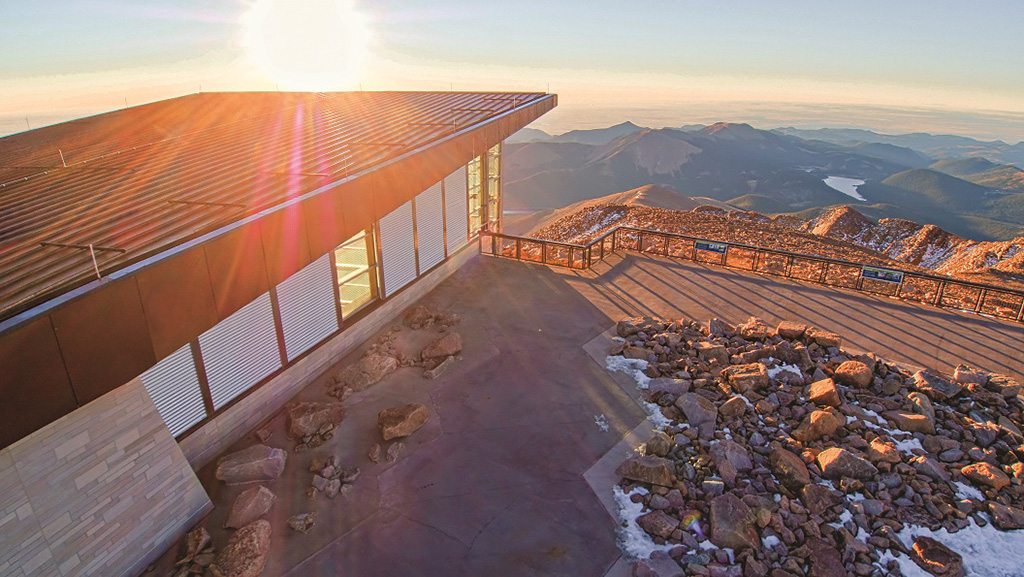
Photo courtesy of Isaiah Industries
High-mountain elevations can experience high-wind events with wind speeds similar to coastal regions.
Florida Building Code Protocol: TAS 111(B)-95 – Edge Metal Pull-Off Performance
In coastal regions subject to hurricane activity, edge metal components are among the most vulnerable elements of the roofing system. When these fail under uplift pressure, the damage can quickly escalate, often resulting in a total roof failure. To address this critical vulnerability, the Florida Building Code mandates testing to TAS 111(B)-95, the Test Procedure for Edge Metal Pull-Off Performance.
This protocol was developed by the Florida Building Commission as part of the High Velocity Hurricane Zone (HVHZ) requirements and is specific to edge metal systems such as facias, drip edges, and gravel stops. The goal of TAS 111(B) is to verify that these components can resist wind uplift forces without detaching from the structure. Testing is conducted on full-size samples mounted to a structural substrate, with increasing vacuum pressure applied until pull-off or failure occurs. The results provide a clear indication of the maximum wind pressure the assembly can endure and whether it meets the design requirements for HVHZ compliance.
One important feature of the TAS 111(B) protocol is that it accounts for the interaction between the metal edge, the membrane roofing, and the substrate fastening. This system-level testing ensures that performance is not based solely on individual product attributes but on the installed conditions holistically. Manufacturers must submit test data to the Florida Product Approval system, and only approved configurations are allowed for permitted construction in the HVHZ regions of Miami-Dade and Broward counties.
Design professionals working outside Florida should still consider TAS 111(B) as a best-practice benchmark, particularly in the Gulf Coast, Southeast, and other storm-prone areas. By specifying edge metal components tested to this standard, architects and contractors can reduce the likelihood of progressive failure during wind events and support insurance and resilience goals.
Florida Building Code Protocol: TAS 111(C)-95 – Coping Cap Pull-Off Performance
The companion test to TAS 111(B), the TAS 111(C)-95 protocol, focuses on coping caps—protective edge elements installed along the tops of parapet walls. Coping caps also undergo intense uplift pressures during high wind events, especially as wind is deflected up and over parapets. Failure at these locations can lead to rapid exposure of roof membranes, water intrusion, and loss of structural continuity across the wall-roof interface.
TAS 111(C) provides a standardized method for determining the pull-off resistance of coping caps installed over concrete, CMU, or wood-framed parapets. The test involves applying increasing vertical uplift forces until detachment occurs, recording both the load at failure and whether failure was a result of fastener pull-out, material tearing, or substrate compromise. Results again must be based on complete system assemblies, including substrate, fasteners, membrane interface, and any sealants or blocking.
One of the strengths of the TAS 111(C) protocol is that it addresses real-world conditions, including the presence of sloped caps, two-piece metal configurations, or sealant-integrated designs. Because coping caps form the uppermost termination of the wall assembly, their integrity is essential for resisting water entry, maintaining pressure equalization, and preventing uplift cascade failures. In design scenarios that include both parapet walls and metal roofing or wall panels, TAS 111(C)-tested coping systems help ensure the edge terminations match the performance of the rest of the envelope. As with TAS 111(B), products tested and approved under TAS 111(C) appear in the Florida Product Approval database and are often labeled with Miami-Dade NOA (Notice of Acceptance) documentation.
Wind load resistance is not just a structural engineering concern—it’s a decisive factor in a building surviving extreme weather to return to service quickly. The performance of metal roofing and edge systems during high-wind events hinges on a combination of material strength, system configuration, and strict adherence to testing protocols. These standards reflect real-world failure patterns and are instrumental in preventing the progressive damage that often begins at roof perimeters and corners.
Andy Williams, principal consultant for Panel Cladding Solutions in Alva, Florida, and Director of Codes and Standards for the Metal Construction Association, has decades of experience with solution-oriented design in HVHZ regions. Williams notes the effective protection that metal can provide to structures often exposed to high winds and severe storms.
“After years of doing business in Florida, one thing is clear: durability matters—and metal roofing consistently proves its value in high-wind zones,” Williams says. The combination of Florida’s strict building codes, rigorous product approval process, and active hurricane season requires materials that can withstand extreme weather. Williams notes that metal roofs meet—and often exceed—those expectations.
Considering that many metal systems are rated to withstand winds over 140 mph, Williams adds that when properly installed, standing seam metal roofs offer a level of storm protection that’s become essential for property owners across the state. “Beyond strength, metal roofs offer added benefits like energy efficiency, moisture resistance, and modern curb appeal—making them a smart, future-proof investment in Florida’s challenging climate,” he says.
Fire Resistance and Ignition Prevention
Wildfire disasters have also been on the rise. Human development into the more rural and heavily forested areas, combined with extended droughts, has literally fueled the increase in wildfires.
In August 2023, the Maui wildfires devastated the historic town of Lahaina, killing at least 101 people and marking the deadliest U.S. wildfire in over a century. More recently, in early 2024, fast-moving Los Angeles-area wildfires, intensified by Santa Ana winds, forced evacuations in communities from Topanga Canyon to Malibu, destroying homes and threatening some of the most densely developed areas in the wildland-urban interface. In December 2021, Colorado’s Marshall Fire spread rapidly through Boulder County suburbs. Fueled by wind gusts exceeding 100 mph, it leveled over 1,000 structures in hours.
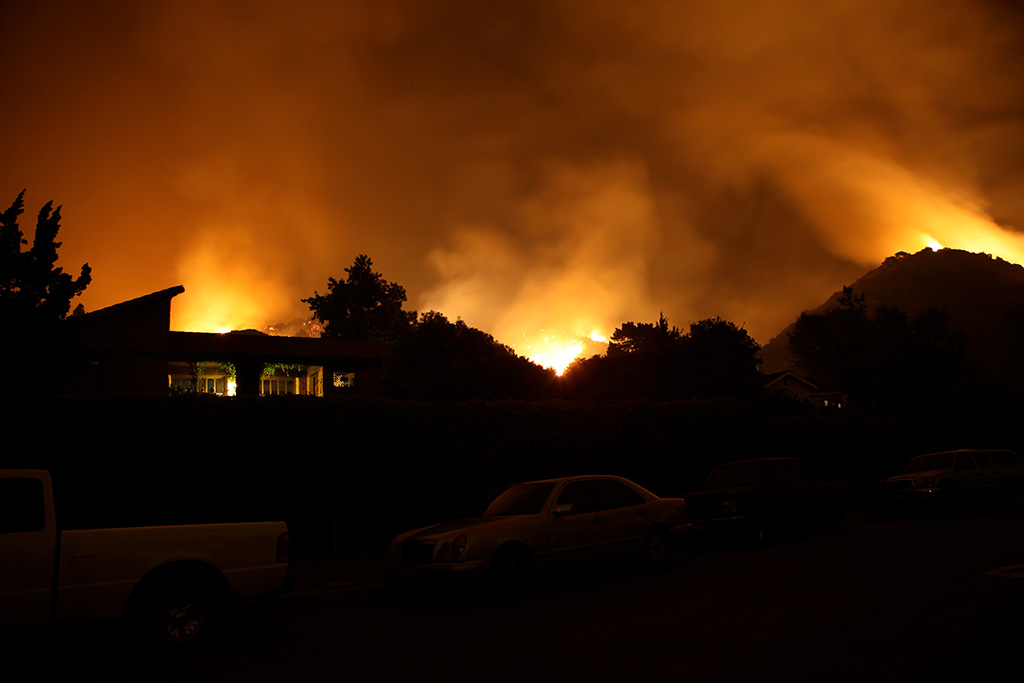
Photo courtesy of Getty Images
While historically only considered a seasonal threat to the Western United States, wildfires are now a year-round reality in almost every region.
Wildland-urban interface (WUI) zones are areas where development meets undeveloped wildlands such as forests, grasslands, or shrublands that serve as fuel during wildfire events. According to the U.S. Fire Administration, approximately 4.5 million U.S. homes are located in WUI areas, and that number continues to grow. From 2005 to 2020, WUI acreage increased by 41%, driven largely by development pressures and migration into scenic or rural areas1.
Here, ember exposure is the leading cause of structure ignition. Burning embers carried by wind ignite combustible roofing, accumulate in gutters and roof-wall transitions, or enter attics through soffit vents. Once a structure catches fire, the proximity of homes and lack of defensible space can lead to rapid spread through neighborhoods, often overwhelming firefighting resources.
Metal Roofing: Non-Combustible and Ember-Resistant
As wildfires continue to intensify, the need for building materials that resist ignition and prevent fire spread is increasingly urgent. In this context, metal building components offer not only superior performance but also peace of mind. Their inherent fire resistance, combined with code-tested assembly ratings and strategic detailing, makes them a cornerstone of fire-adapted design.
Metal roofs are Class A fire-rated when installed over appropriate underlayment and sheathing. Unlike wood shakes or asphalt shingles, they do not ignite, melt, or contribute fuel to a fire. Metal also sheds embers more effectively than irregular, textured surfaces.
Standing seam metal roofs are recognized by multiple building organizations and industry programs as one of the most effective strategies to mitigate wildfire risk. The design of standing seam metal roofs reduces the number of potential ignition points due to the tightly interlocked design without exposed fasteners. With no organic content, these roofs do not smolder or degrade under ember attack. Additionally, metal roofs can be paired with fire-resistant underlayment to meet or exceed ignition-resistant construction standards defined by codes such as California’s Chapter 7A of the CBC.
California’s Chapter 7A of the California Building Code (CBC)
Adopted in 2008, California’s Chapter 7A of the California Building Code (CBC) applies to new buildings constructed in areas designated by the state as “Very High Fire Hazard Severity Zones” (VHFHSZs) and outlines specific ignition-resistant construction requirements intended to limit the risk of structural ignition from embers, radiant heat, and direct flame contact. This reflects a shift in building safety strategy from merely surviving fires to actively preventing ignition in the first place.
The code mandates that vulnerable components of a home—such as roofs, vents, eaves, exterior walls, decks, and windows—be constructed using materials and designs that have been tested and approved for wildfire exposure. Similarly, decks and under-eave assemblies must demonstrate performance in standardized fire exposure tests. These targeted strategies are grounded in fire science, with findings from post-fire investigations showing that most home ignitions in WUI zones begin with embers penetrating weak points in the building envelope.
Chapter 7A has become a foundational policy tool in safeguarding communities built at the wildland-urban interface and is the statewide minimum for construction in VHFHSZs. While the code only applies to new construction, it has set a precedent for resilience, prompting broader discussions around retrofitting, future-proofing, and increasingly, insurance incentives.
Insurance Against Disaster
Both the cost and availability of insurance for residential and commercial buildings have been impacted by the frequency and severity of major wildfire events. Costs have increased nationally, and in many regions, insurance companies are no longer offering coverage if structures are in WUI zones. Those that do still offer coverage have recognized the value of fire-resilient construction, specifically metal roofing.
In field studies following major wildfires such as the Marshall Fire, homes with metal roofs were among the few to remain standing amidst widespread destruction. Post-fire assessments by the National Institute of Standards and Technology (NIST) and the Insurance Institute for Business and Home Safety (IBHS) have confirmed the vital role of non-combustible roof assemblies in structure survivability.
Programs like California FAIR Plan and My Safe California Home offer rebates or credits for fire-hardened upgrades, including metal roof installation. In Oregon, new funding mechanisms under Oregon’s Senate Bill 762 support home hardening initiatives and education, with specific references to Class A roofing as a minimum requirement for grant eligibility2.
Wildfire Prepared Neighborhood Technical Standard
Recognizing the need for a holistic approach to wildfire risk, IBHS introduced the Wildfire Prepared Neighborhood Technical Standard—a science-based framework for reducing community-scale fire vulnerability. The standard integrates defensible space, non-combustible construction, and emergency planning into one coordinated system. Its three primary objectives are:
- Minimize ember ignition risk: through fire-resistant building materials, sealed vents, and Class A roofs (e.g., metal).
- Improve emergency response: via neighborhood signage, street widths, and clear address visibility.
- Maintain survivability zones: by defining clearings and hardscapes that prevent flame contact with structures.
In promoting the standard, IBHS highlights metal roofs, soffits, and wall systems as key tools in meeting ember resistance targets. According to the standard, homes should be equipped with Class A roofs and ignition-resistant siding materials, such as steel, aluminum, or cementitious products. Eaves should be enclosed, and vent systems should include ember-resistant screening or baffled designs.
The standard is gaining traction in states like California, Oregon, and Colorado—either through municipal adoption or voluntary incentive programs- and local governments and developers are beginning to align zoning and permitting with it. For example, the City of Boulder’s Wildland-Urban Interface Code closely mirrors IBHS recommendations and mandates non-combustible exterior materials in high-risk zones.
Protecting from Fire Within
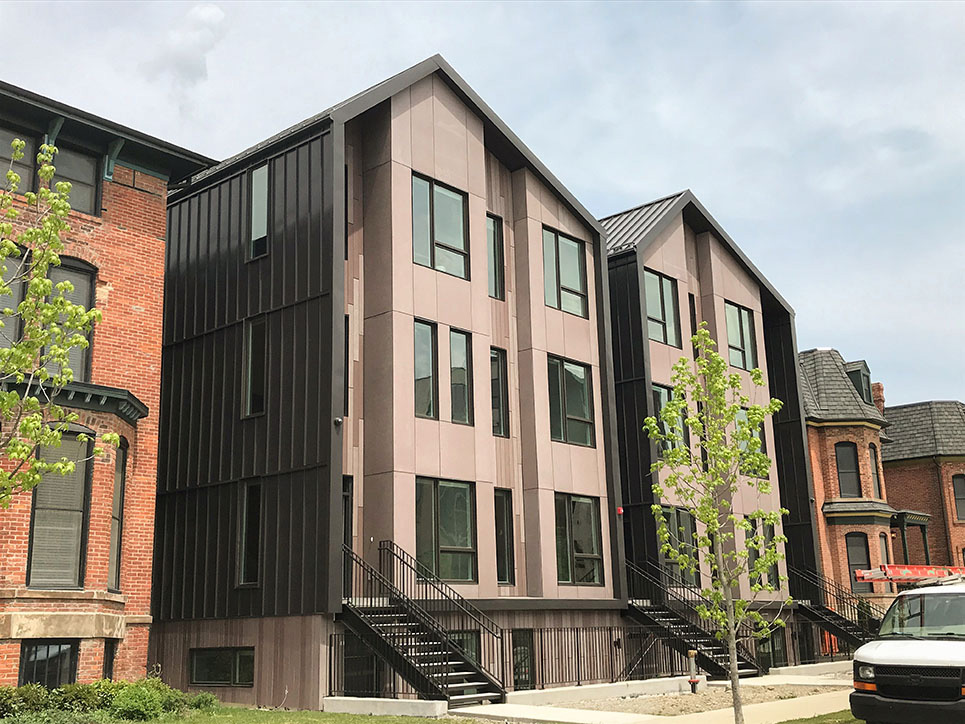
Photo courtesy of ATAS
NFPA 285 is a critical standard in multi-story buildings to validate a wall assembly’s ability to limit vertical and lateral flame spread of a fire source located on the lower floor.
Metal roofing and eaves serve well to protect the structure from flying embers; however, should the walls be exposed to radiant heat or direct flame, compartmentalizing the flame and limiting its spread is critical to survival. This is especially true in multifamily buildings or multi-story commercial construction. Designing and building a structure to withstand fire from within the building is imperative to limit overall damage, allow occupants time to escape, and give first responders more time.
Metal wall systems, including insulated metal panels (IMPs) and rain-screen assemblies, offer superior fire resistance in this scenario. They often incorporate mineral wool or polyisocyanurate insulation encased in metal skins, providing both thermal performance and ignition resistance. In non-combustible wall construction, metal panels act as the first line of defense against radiant heat, flame impingement, and ember accumulation.
When combustible materials such as foam insulation are included in wall assemblies, performance-based testing becomes essential. NFPA 285, the “Standard Fire Test Method for Evaluation of Fire Propagation Characteristics of Exterior Non-Load-Bearing Wall Assemblies,” addresses this challenge. It evaluates how wall systems, including cladding, insulation, air barriers, and substrates, respond to fire originating from a window opening by simulating flashover conditions.
NFPA 285: A Benchmark for Exterior Fire Performance
The NFPA 285 test simulates a two-story wall with a fire source located on the lower floor. Flames and heat exposure are applied through a window opening, and the system must limit vertical and lateral flame spread. Metal wall assemblies, when detailed and fastened appropriately, often pass this test due to their limited combustibility and the ability to compartmentalize fire spread.
Many IMPs and ventilated metal façades have achieved NFPA 285 compliance, allowing their use in mid-rise and high-rise applications under IBC Types I–IV construction. This is especially critical in WUI-adjacent urban areas, where multi-story structures require both code compliance and resilience against ember exposure.
Fire Is Spreading
Though much attention has been given to wildfires in heavily timbered areas, increasingly large fire events are occurring in unexpected areas outside traditional fire seasons. The Smokehouse Creek Fire in February of 2024 burned over 1 million acres and is the largest wildfire on record for Texas. The event destroyed dozens of homes and led to widespread livestock loss.
In New Jersey, the Jones Road Fire burned over 15,000 acres in Ocean County in late April 2025. The fire, determined to be arson-caused, prompted the evacuation of thousands of residents and threatened more than 1,300 structures.
In Florida, the Brushy Crossing Fire ignited in Liberty County in February 2024, well before the state’s typical wildfire window. It consumed over 2,200 acres during a period when cooler temperatures would normally reduce fire activity, but persistent drought and dry vegetation contributed to rapid spread. Close by, the Okefenokee area of Georgia experienced one of its largest recent fires in spring 2024, when lightning sparked the Bugaboo Complex Fire. Merging with other nearby blazes, it ultimately burned over 560,000 acres across the Georgia-Florida border. This fire forced temporary highway closures and large-scale evacuations.
Reviewing the size, nature, and timing of these fire events illustrates the fact that wildfire events are no longer relegated to the mountainous West. The specification of metal roofs and wall systems provides both peace of mind and a sound financial investment in resilient design in all communities and building types.
Flood Durability and Moisture Resistance
Flooding presents a complex and often devastating challenge to buildings by testing not just structural resilience, but the durability and recoverability of every material used. When a building is inundated, components such as drywall, wood framing, insulation, flooring, and cladding can quickly degrade, creating conditions for mold growth, structural rot, and indoor air quality hazards. Recovery from flood damage can take months and require extensive material replacement.
According to research published by The Federal Emergency Management Agency (FEMA), flood insurance claims between 2016-2020 averaged close to $52,000. Due to more severe weather events, flood events are becoming more common as well, accounting for over 60% of FEMA disaster declarations in 2023.3
Floodwaters are not simply water. They carry sediment, bacteria, sewage, chemicals, and debris, all of which exacerbate the damage done to porous or organic materials. When wood framing or gypsum wallboard becomes saturated, it can swell, delaminate, and support microbial growth within 24–48 hours. These materials must often be removed and replaced entirely, especially when water remains for extended periods.
Photo courtesy of Getty Images
Flooding can create more than just financial hardship for building owners with health concerns over mold growing on wetted material. Metal wall and framing systems can mitigate much of the risk of mold growth while providing structural strength.
Metal components, however, are impervious to water absorption. Galvanized steel, aluminum, and coated steel framing members do not swell or harbor mold when submerged. Exterior cladding and interior framing systems made from metal can be pressure-washed, disinfected, and reused after drying, saving significant time and cost during flood recovery. FEMA recognizes this advantage and lists metal wall and ceiling systems as “acceptable materials” for use in flood-prone areas when properly detailed.4
In the FEMA-defined Special Flood Hazard Areas (SFHAs), structures below the base flood elevation (BFE) are often required to use flood damage-resistant materials in any portion that may be exposed to floodwaters. FEMA’s classification system ranks materials by their ability to resist flood damage, with galvanized metal, stainless steel, and aluminum earning the highest ratings. These materials are recommended not just for cladding but also for flooring systems, mechanical supports, and protective barriers.
Metal Cladding and Flood Recovery
Metal wall panels, especially those used in rainscreen or insulated metal panel (IMP) configurations, are particularly effective in resisting moisture intrusion. These systems typically include factory-applied finishes such as PVDF coatings or galvanized zinc layers that protect against rust and chemical corrosion. When combined with appropriate air and moisture barriers, metal cladding creates a ventilated cavity that limits water retention and accelerates drying.
In flood-prone areas, the use of metal cladding systems over non-paper-faced gypsum or cementitious sheathing provides a highly resilient envelope. Even in events where water enters the wall cavity, the inorganic materials used in metal systems reduce the risk of mold formation and structural compromise. In many cases, panels can be removed, cleaned, and reinstalled without replacing the entire wall system.
Case studies from post-hurricane recovery efforts, such as after Hurricanes Harvey (2017) and Ian (2022), show that metal buildings often returned to service weeks or even months ahead of neighboring structures made from wood or masonry veneer. Industrial and commercial buildings with pre-engineered metal panels and steel framing were able to withstand both wind and flood forces, allowing business owners to begin cleanup and restoration as soon as floodwaters receded.
Framing and Interior Assemblies
Steel framing, widely used in both load-bearing and non-load-bearing wall systems, offers significant advantages in flood resilience. Unlike wood, steel studs do not wick water, swell, or rot. In submerged conditions, cold-formed steel retains its shape and strength, provided the protective zinc coating remains intact and corrosion is limited. Post-flood restoration typically involves drying the structure, inspecting for corrosion, disinfecting, and reapplying any protective coatings—far simpler and less invasive than the full replacement often required with wood-framed assemblies.
Additionally, the use of steel trusses, joists, and suspended ceiling systems prevents sagging, warping, and microbial degradation. This is especially important in critical facilities such as hospitals, emergency shelters, and utilities, where uninterrupted service and fast recovery are essential. FEMA’s Recovery Advisory RA5 (2011) recommends metal components in these environments for their predictable performance and ease of cleaning.5
Moisture and Mold Resistance
Mold is among the most persistent and expensive consequences of flooding. Mold can begin to grow in damp conditions within 24–72 hours, particularly on materials that contain cellulose or other organic compounds. This includes traditional drywall, wood framing, carpeting, and many forms of insulation. Once mold colonizes a building, remediation involves not just cleaning but often the complete removal and replacement of affected components.
Metal components, by contrast, are non-nutritive for mold. Steel and aluminum do not support biological growth even when wet. While surface mold may appear on dirty or uncoated metal surfaces under certain conditions, it does not penetrate or degrade the material. This gives flood-damaged buildings constructed with metal systems a key advantage in indoor environmental quality after water exposure.
Metal-framed interiors can also be paired with mold-resistant gypsum panels, mineral wool insulation, and waterproof coatings to further improve resilience. Together, these systems form part of a growing category of “dry floodproofing” design strategies aimed at minimizing recovery time and protecting occupant health.
Insurance and Incentives
Building with flood-resilient materials like metal doesn’t just improve building resilience; it can reduce insurance costs and support compliance with local codes and incentive programs.
The National Flood Insurance Program (NFIP), administered by FEMA, supports communities in reducing flood risks through improved construction and planning practices. One of its most effective incentives is the Community Rating System (CRS), a voluntary program that rewards municipalities for implementing floodplain management strategies that exceed minimum NFIP requirements. Communities that adopt higher standards, such as requiring the use of flood-damage-resistant materials like metal, elevating structures above the BFE, or improving stormwater management, can earn CRS points that translate into premium discounts for residents’ flood insurance policies.
Metal building systems can contribute to CRS credits by reducing the risk and severity of insured losses. The CRS uses a tiered classification system, from Class 10 (no discount) to Class 1 (up to 45% discount). Typical activities that earn credits include preserving open space in floodplains, enforcing stricter building codes, maintaining elevation certificates, and running public outreach programs on flood risks. For example, communities that enforce the use of compliant materials, such as metal components designated flood-damage-resistant under FEMA’s Technical Bulletin 2, may improve their CRS score and reduce local insurance costs.
Additionally, state and federal grants—including FEMA’s Hazard Mitigation Grant Program (HMGP) and Building Resilient Infrastructure and Communities (BRIC)—often prioritize funding for resilient construction practices. Projects that incorporate metal framing, siding, and roofing in flood-prone zones may be more competitive for funding due to the quantifiable reduction in long-term risk and repair costs.
More Benefits of Building with Metal
The threats of wind, fire, and flood are priority issues to address for resilient design and construction, but metal roofs, cladding, and structural framing can address a litany of other issues and provide additional benefits.
Hail
In hail-prone regions, metal roofing systems offer unmatched durability. Most are rated Class 4 under UL 2218, which is the highest possible impact resistance designation. Class 4 requires material that can withstand 2-inch steel ball impacts without cracking or compromising waterproofing. Unlike asphalt shingles, which often fail after a severe storm, metal roofs maintain structural integrity even when cosmetically dented. This prevents water infiltration, reduces repair costs, and ensures long-term performance. Many insurers offer premium discounts for homes with Class 4-rated roofs, especially in hail-prone states like Texas, Colorado, and Oklahoma, helping offset higher upfront material costs.
Salt and the Marine Climate
Along coastal areas, salt and high humidity present a challenge for buildings, along with the threat of flooding and high winds. In these regions, metal is increasingly favored for both structural and aesthetic reasons. Aluminum and stainless-steel cladding systems, which resist oxidation and corrosion even in marine environments, are often specified for their long-term performance.
Standing seam metal roofs with raised fasteners and factory-applied finishes offer decades of waterproof protection, often backed by warranties of 30–50 years.
Snow Loads
Moving from warm and humid to cold and icy, metal roofs are valued for their ability to shed snow efficiently. Their smooth, non-textured surfaces reduce snow accumulation and help prevent ice dams, which are a common cause of water infiltration and structural strain. Metal does not absorb moisture or degrade when exposed to freeze-thaw cycles, providing more resilient protection with minimal seasonal maintenance. Snow retention systems such as bars or cleats can be installed to control snow slides, preventing damage to gutters, walkways, and landscaping.
Energy Efficiency
While much of this article has focused on mitigating threats, metal can also be an attractive option both visually and sustainably. Metal roofing contributes meaningfully to building energy performance. Its low thermal mass and high reflectivity reduce heat absorption during hot weather. Energy Star-qualified finishes reflect infrared radiation, minimizing solar heat gain and reducing HVAC demand. These systems often outperform conventional roofing in cooling-dominated climates and support compliance with LEED, Title 24, and other green building codes. Additionally, metal roofs cool rapidly after sunset, improving nighttime energy efficiency and overall occupant comfort.
Solar-Ready Solutions
Further exploring the sustainable benefits, metal roofs, particularly standing seam profiles, are ideal platforms for photovoltaic (PV) systems. Solar panels can be clamped directly to the seams without penetrating the roof surface, reducing leak risk and preserving warranties. This integration simplifies installation and maintenance while extending the lifespan of the PV array. Additionally, combining metal roofing with reflective coatings and battery storage solutions creates a resilient, energy-efficient system capable of maintaining power during utility shutoffs or wildfire-related outages.

Photo courtesy of ATAS
Standing seam metal roof profiles are ideal for photovoltaic (PV) systems and can be clamped directly to the seams without penetrating the roof surface.
Industry in Resilient Action
As climate risks escalate and building owners demand greater long-term value, the construction industry is rethinking the materials and systems that define resilient design. In response to this growing urgency, the Metal Construction Association (MCA) has launched a new Resiliency Council—a strategic initiative aimed at elevating performance standards and positioning metal systems as a core solution in disaster-resistant construction.
The council’s mission is to promote the use of metal in buildings that must withstand extreme conditions from hurricanes, wildfires, hail, or floods. But its work goes beyond marketing. The Resiliency Council is focused on collaborating with building code officials, insurers, architects, and engineers to drive a shift toward performance-based specifications that extend beyond minimum compliance. These efforts reflect a broader movement within the construction industry that is often referred to as future-proofing, or building not just for today’s code, but for tomorrow’s risk landscape.
At the heart of the Council’s approach is advocacy for materials and assemblies that support continuity of operations, rapid recovery, and reduced insurance claims after disaster events, or in essence, resilient design and construction.
The Council is working to quantify and document the benefits metal can offer through research partnerships and case study analysis. This includes expanding the industry’s knowledge base around real-world performance, post-disaster durability, and life cycle cost savings. The MCA Resiliency Council is also advocating for better integration of metal assemblies into resilience-based programs such as IBHS FORTIFIED, LEED Resilient Design Pilot Credits, and FEMA’s Hazard Mitigation programs.
The MCA’s initiative arrives at a critical time. According to the National Oceanic and Atmospheric Administration (NOAA), in 2023 alone, the U.S. experienced 28 separate billion-dollar weather and climate disasters, the highest on record.6 Stakeholders across the built environment—from architects to facility owners—are seeking materials that offer more than just visual appeal. They want systems that will hold up under stress, support climate adaptation, and enhance long-term financial resilience.
The MCA Resiliency Council isn’t just responding to this need—it’s helping define the new standard. By aligning metal construction with resilience-based codes, policy trends, and financial incentives, the council is helping the industry pivot from reactive to proactive design.
Jeff Henry, executive director of MCA, believes that metal as a building material can help support the industry to create a more durable and resilient future. “The formation of the Council is in response to the current narrative in the industry,” Henry says. “We’ve seen the transition in the design build industry over the years as it’s moved from sustainability and greenhouse gas emissions to focus more on resiliency, and that’s understandable considering recent weather events—the intensity and frequency of hurricanes, flooding, and the wildfires out West.”
Henry notes that metal is inherent to resilient design and construction. “We at MCA thought the time was appropriate for us to create a broader initiative around the whole topic in advancing the metal as a resilient material and being part of the solution to help the built environment,” he says. “Metal has a proven history in many of these climate or national disaster type scenarios and has performed at higher levels than alternative cladding systems.”
The Need for Resilient Construction
The call for resilient design and construction is becoming more critical as we continue to see the impact of severe weather events on building owners and occupants. The inclusion of metal in roofing, cladding, or as a structural framing member is not only a viable option for resilient design, but increasingly necessary.
END NOTES
- https://www.usfa.fema.gov/downloads/pdf/publications/wui-issues-resolutions-report.pdf
- https://www.oregon.gov/bcd/codes-stand/Documents/5772-firehardening-standards.pdf
- https://www.fema.gov/openfema-data-page/fima-nfip-redacted-claims-v2
- https://www.fema.gov/sites/default/files/2020-07/fema_tb_2_flood_damage-resistant_materials_requirements.pdf
- https://www.fema.gov/sites/default/files/2020-07/critical-facilities-tornado-regions_facility-owners_recovery-advisory.pdf
- https://www.ncei.noaa.gov/news/national-climate-202312
Andrew A. Hunt is Vice President of Confluence Communications and specializes in writing, design, and production of articles and multimedia presentations related to sustainable design in the built environment. In addition to instructional design, writing, and project management, Andrew is an accomplished musician and voice-over actor, providing score and narration for both the entertainment and education arenas. www.confluencec.com; www.linkedin.com/in/andrew-a-hunt-91b747/






